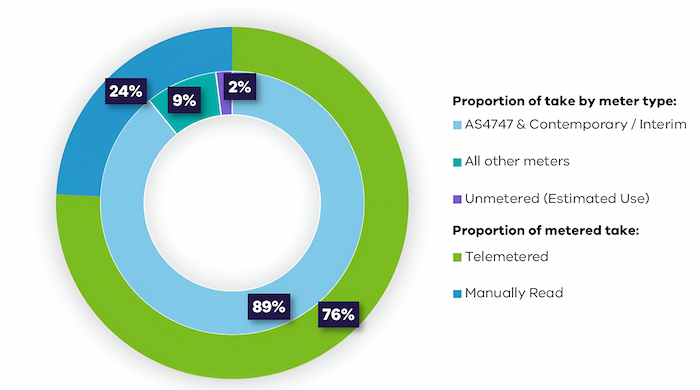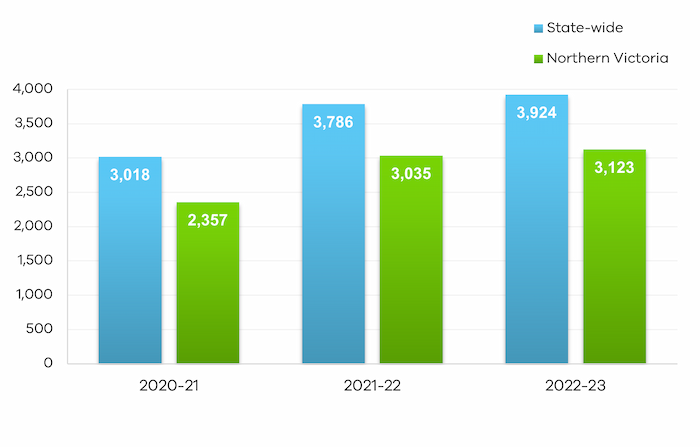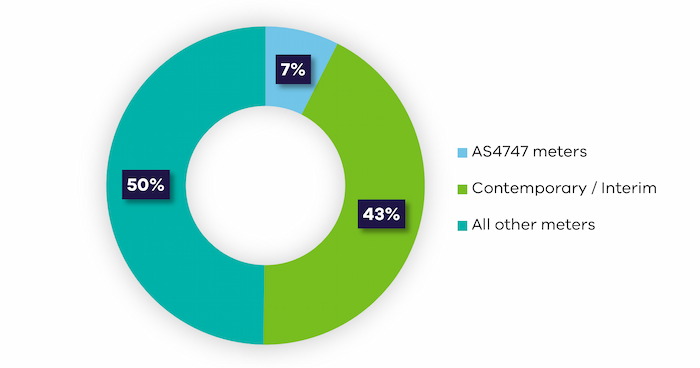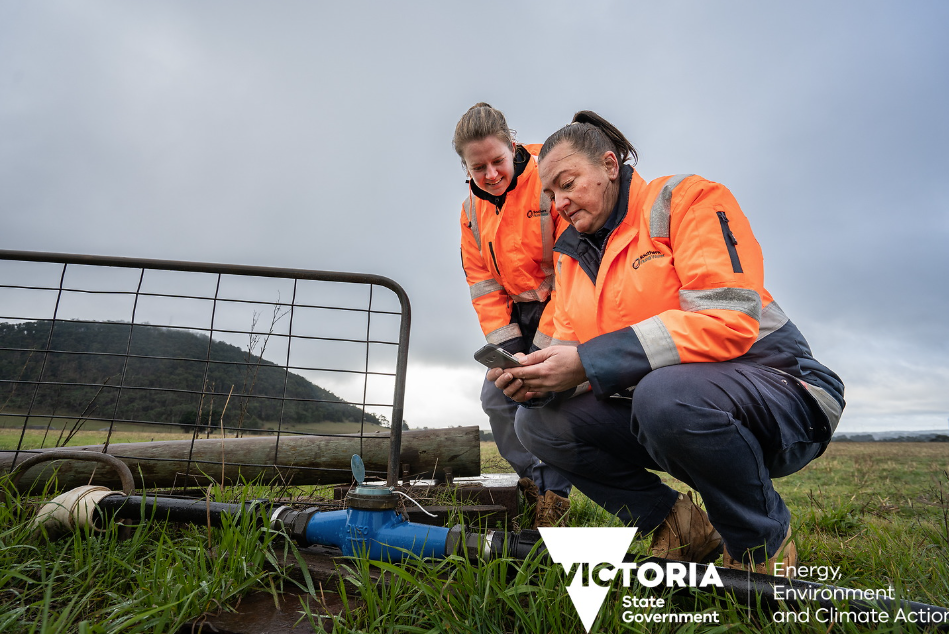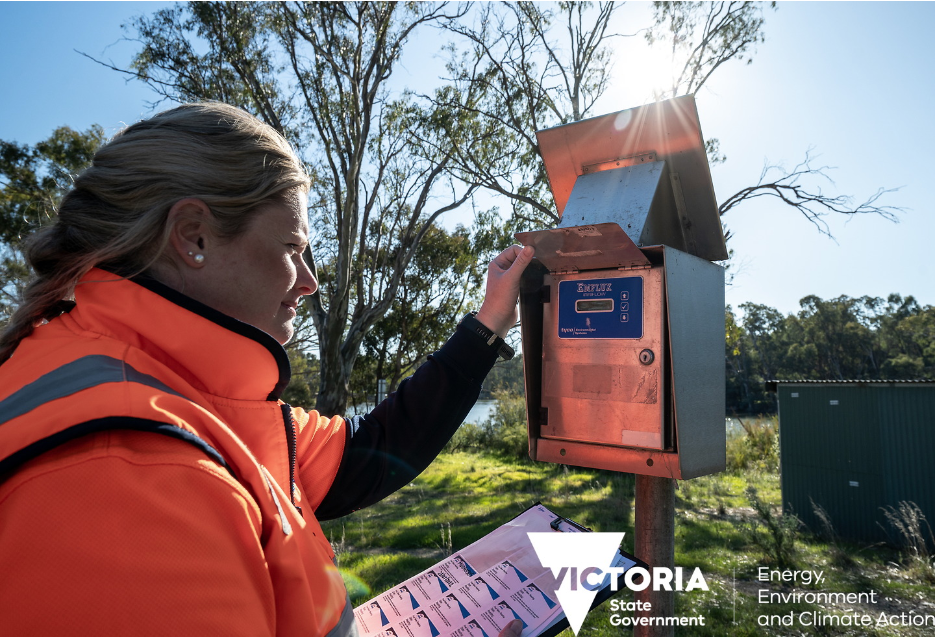On this page:
Non-urban metering is essential for comprehensive water accounting and sustainable water management. Victoria is committed to the effective measurement of non-urban water users’ diversions (metering take).
This report meets Victoria’s continuing obligation to monitor and report on Victoria’s progress in implementing non-urban water metering. All previous metering implementation reports are available and can be found on the Murray-Darling Basin Compliance.
- Victoria’s non-urban water metering policy, in accordance with the Murray Basin Compliance Compact (2018) sets requirements for water corporations and its rural customers to prepare and maintain metering action plans.
- In 2022-23, Victorian Water Corporations implemented metering action plans to deliver high-quality metering services to Victorian non-urban water users.
Victoria's non-urban water metering policy
In 2022-23, DEECA and water corporations reviewed the Victorian non-urban water metering policy and associated metering action plan guidelines. Confirming alignment with the Metrological Assurance Framework (MAF2 2021) for non-urban water meters. The revised policy will be published and available later online in 2024.
Non-urban water metering systems and assets
Victorian water corporations are early adopters of non-urban water metering and national leaders in telemetry and automated control systems.
Metering and telemetry coverage in Victoria
In 2022-23, DEECA with water corporations, established a tool for water corporations to assess the costs and benefits of telemetry installation on meters that are being manually read. Goulburn-Murray Water trialled the use of the tool to examine sites within their Zone 7 – Vic Murray customer base (Zone 7 refers to one of Victoria’s most active regulated water trading zones).
In 2022-23:
- 98% of total water taken via customer service points across Victoria were metered.
- 74% of total water taken in Victoria was telemetered, up from 70% in 2021-22. 76% of water taken through a meter was telemetered.
- 76% of total water take in Northern Victoria was telemetered, up from 69% in 2021-22.
- 353 telemetry devices were fitted to meters. Telemetry allows real-time monitoring of high-volume users and sends data electronically to water corporations.
As of 30 June 2023:
- Of Victoria’s 52,565 meters, 59% are fitted with telemetry across Victoria, a slight increase from 2021-22.
- 62% of meters are telemetered across Northern Victoria, up from 61% in 2021-22.
Metering and telemetering Victoria 2019-2023
Note: In 2020–21, the number of meters reported included small volume domestic and stock customers where exemptions for metering apply, and usage is deemed. In 2019-20 and 2020-21, the number of meters and the number of telemetered meters at the state level were not reported.
Metering accuracy in Victoria
Approximately 85% per cent of meters in Victoria were installed before 2014, which excludes small meters ≤50mm in diameter. The National Measurement Institute approved the first meter for full flowing pipes as complying with the AS4747 standard (pattern-approved) in 2014. From June 2022, there is one pattern-approved meter for open channel meters. The pattern-approved non-urban water meters document provides more information.
In 2022-23:
- 89% of total take was measured via meters across Victoria that meet the ±5 per cent target accuracy set by the National framework for Non-urban metering (2009)
- 16% of take across Victoria was measured via fully AS4747 compliant meters.
The proportion of take measured through AS4747 compliant meters will increase over time. DEECA and water corporations are working to increase the uptake of more AS4747 meters and telemetry. All water corporations have metering action plans, that set out:
- when and where new meters and telemetry will be installed
- when and where non-compliant meters will be replaced, and
- fitting telemetry to metered water take, where the benefits of stronger compliance outweigh costs.
Since the review of the Victorian non-urban metering policy in March 2020, the number of AS4747 compliant meters has increased across the state and in Northern Victoria). As of 30 June 2023, 7% of meters (or 3,924 meters) are AS4747 compliant across Victoria).
In 2022-23, 2% of water take was estimated, where a service point may not be metered. Water corporations can vary meter requirements in certain circumstances. A metering rule can be varied where:
- risks are manageable, including where adequate water measurement is provided by bulk water metering
- costs outweigh benefit (i.e., small volume take for domestic and stock purposes)
- the site requires the application of hydrometric monitoring standards.
Bulk water metering in Victoria
Water corporations are granted bulk entitlements by the Minister for Water. The entitlements provide the right to take, store and use water subject to specified conditions and obligations. Water corporations have bulk entitlement metering programs aligned to the Minister’s Guidelines for bulk entitlement metering programs publicly disclose take under bulk entitlements in annual reports tabled in Parliament and in the Victorian Water Accounts.
The Minister for Water approved the revised Guidelines for Bulk Entitlement Metering Programs in November 2021. The guideline was updated to reflect contemporary water management policy, practices, and standards and to address specific issues identified by bulk and environment holders during the review process.
Metering and compliance in 2022-23
The Victorian Government has a zero-tolerance approach to unauthorised take. As well as accurate meters, other important components of metering that enable effective compliance and enforcement are:
- meters are read, inspected, and maintained by water corporation staff
- 74% of customers’ take is telemetered. This means water corporations receive data electronically at a close to real time frequency. This can be used by water corporations to monitor and enforce compliance more regularly
- bulk water measurement facilitates accounting and has a high level of public disclosure via published annual water accounts and water corporation annual reports that are tabled in parliament; and
- automated control systems in many modernised irrigation districts give water corporations accurate information about deliveries and losses. This prevents people from ordering more water than they are authorised to take.
In 2022-23, meters were manually read 57,191 times in Northern Victoria, and 68,887 times state-wide by water corporation staff. These numbers include inspections related to compliance and meter maintenance.
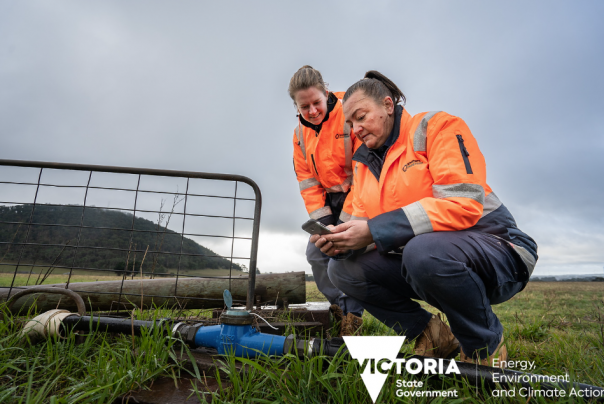
- Manual non-urban water meter reading

- Telemetry device reading
Victoria as part of the Murray-Darling Basin
DEECA represents Victoria for non-urban water metering on the Commonwealth and Murray-Darling Basin level. In 2022-23, DEECA continued as an active member of the Inspector General of Water Compliance’s Metering Report Card Working Group to ensure Victoria’s metering reform is transparently reported on.
All previous IGWC Metering report cards can be found on the Inspector General’s website.
Non-urban water metering priorities in 2023-24
DEECA and water corporations will continue to implement actions from the state policy and metering action plans. This including:
- DEECA and water corporations finalising the 2023 review of the Victorian Non-urban water meter policy and associated meter action plan guidelines to ensuring requirements of the Metrological assurance framework (MAF2) for non-urban water meters and any guidelines and standards issued by the Inspector-General of Water Compliance are met.
- Water corporations are assessing the costs and benefits of installing telemetry on meters that are still being read manually and updating their metering action plans. DEECA will continue to oversee the telemetry uplift program in Goulburn-Murray Water’s Zone 7 customer base.
- DEECA assessing revised water corporation bulk entitlement metering programs to ensure consistency with revised guidelines for bulk entitlement metering programs.
- DEECA and water corporations commencing a review of unmetered rural water take measurement methodology to accurately calculate unmetered or deemed rural water use for customer billing, compliance, and water resource management purposes.
- Metering coordinators from water corporations with rural customers sharing information on meter and telemetry performance. Implementing the policy, and improving metering practice. DEECA and water corporations will review the implementation of metering action plans against 2025 policy targets.
Page last updated: 12/12/25

